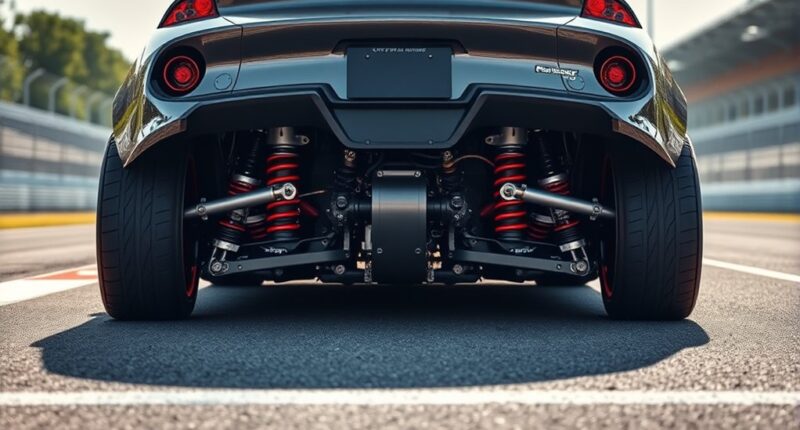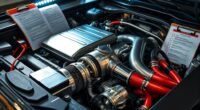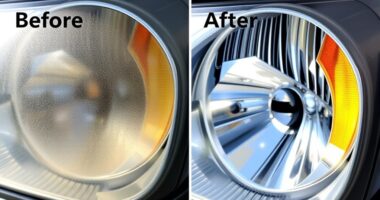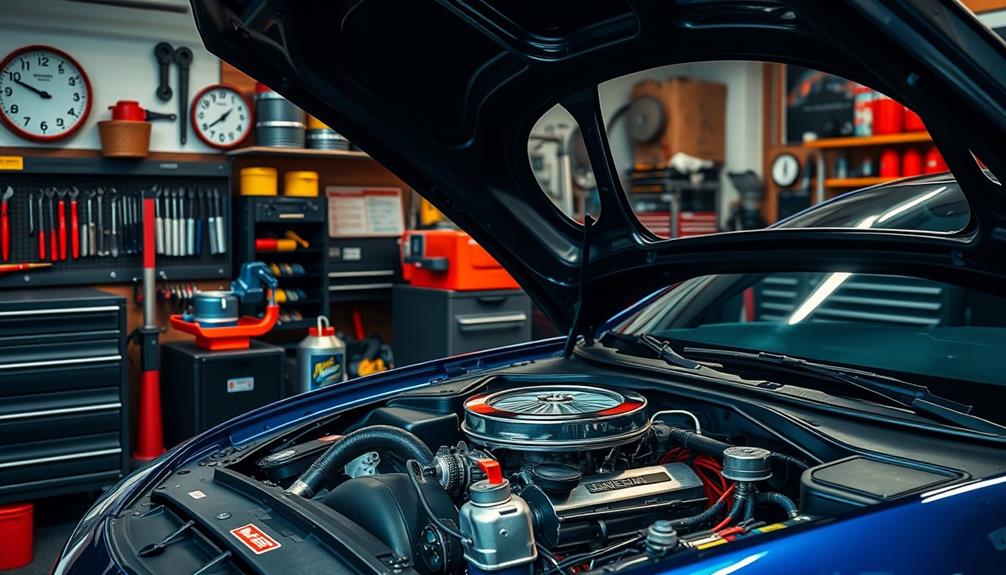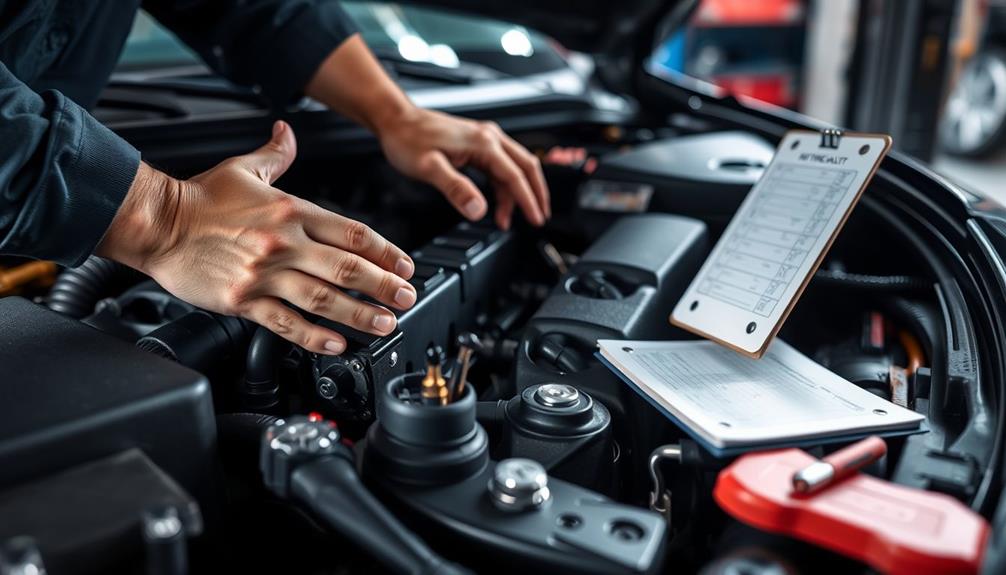To choose the right suspension setup for your tuned car, consider your driving style and performance goals—whether it’s handling, comfort, or speed. Select components like springs, dampers, and stabilizer bars that match your needs, balancing stiffness and compliance. Opt for high-quality materials and damping technologies, such as monotube shocks or adjustable coilovers, to fine-tune the setup. For a full understanding of customizing your suspension, explore the detailed tips below.
Key Takeaways
- Match spring rates and damping settings to your driving style and performance goals for optimal handling and comfort.
- Choose adjustable shocks and sway bars to fine-tune body roll, stability, and responsiveness during cornering.
- Select suspension components based on material durability, weight savings, and budget considerations.
- Properly align and set your suspension geometry to enhance tire contact, steering response, and overall vehicle balance.
- Consider your vehicle’s primary use—street, track, or daily driving—to determine the ideal balance between ride comfort and handling performance.
Understanding Your Vehicle’s Dynamics and Goals
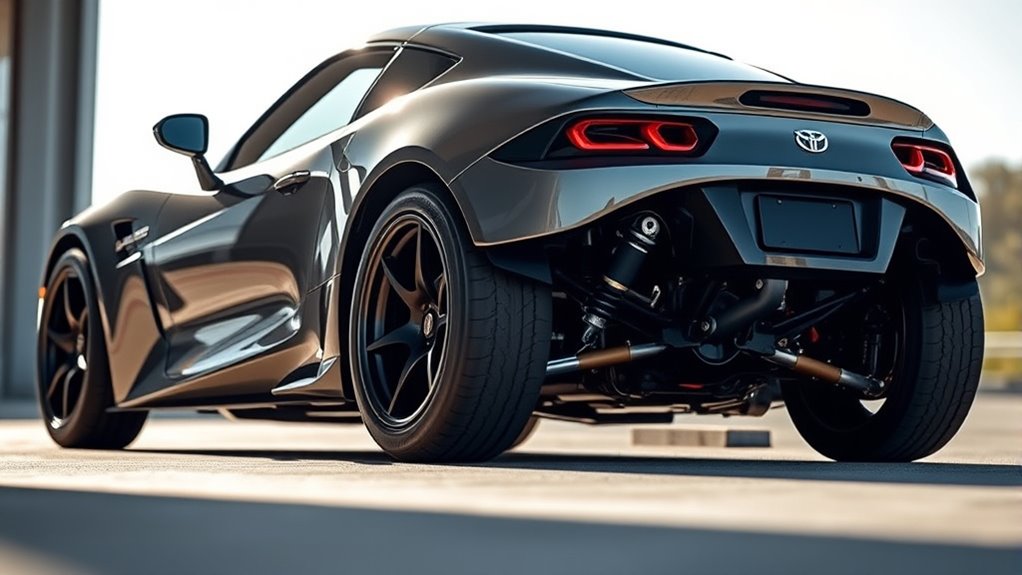
To effectively tune your vehicle’s suspension, you first need to understand its dynamics and your performance goals. Vehicle dynamics include tyre, longitudinal, lateral, and vertical behaviors, all influencing handling and stability. Continuous technological advancements in vehicle design and active systems mean that modern suspensions can be finely tuned to adapt to different driving conditions and preferences. Your suspension system controls wheel kinematics during acceleration, braking, and turns, affecting how the car responds. Recognizing issues like understeer and oversteer helps you identify what needs adjustment. Traction limits, dictated by power and road conditions, also impact performance. Additionally, calculating braking energy based on vehicle inertia ensures ideal stopping power. Understanding vehicle behavior and how suspension adjustments influence it is crucial for achieving your desired setup. The role of suspension in controlling wheel kinematics becomes even more significant when considering the vehicle’s overall handling characteristics. Your goals—whether maximizing speed, handling, comfort, or a balance—guide your setup choices. By understanding these core dynamics, you set a solid foundation for tuning a suspension that matches your driving style and environment.
Selecting the Appropriate Suspension Components

Choosing the right suspension components is essential for achieving your vehicle’s desired handling and performance. Start by selecting shocks and dampers that suit your driving style, whether adjustable units for fine-tuning or high-performance monotube shocks for better heat dissipation. Understanding each component’s function helps you make informed decisions and tailor your setup effectively. Rebound stiffness tuning helps control weight transfer, reducing oversteer or understeer, while bump stops prevent bottoming out during aggressive driving. Anti-roll bars, especially adjustable ones, balance cornering grip by controlling body roll; thicker front bars improve turn-in, while rear adjustments optimize rotation. Fine-tune toe, camber, and caster to enhance steering response and tire contact. Upgrading bushings and mounts with polyurethane or spherical bearings sharpens feedback, but consider NVH. Suspension tuning strategies can further refine handling characteristics based on your specific driving needs. Additionally, considering vehicle weight distribution can significantly impact handling and stability. Finally, adjust ride height and corner balance to optimize weight distribution and overall handling characteristics.
Spring Rates and Their Impact on Handling
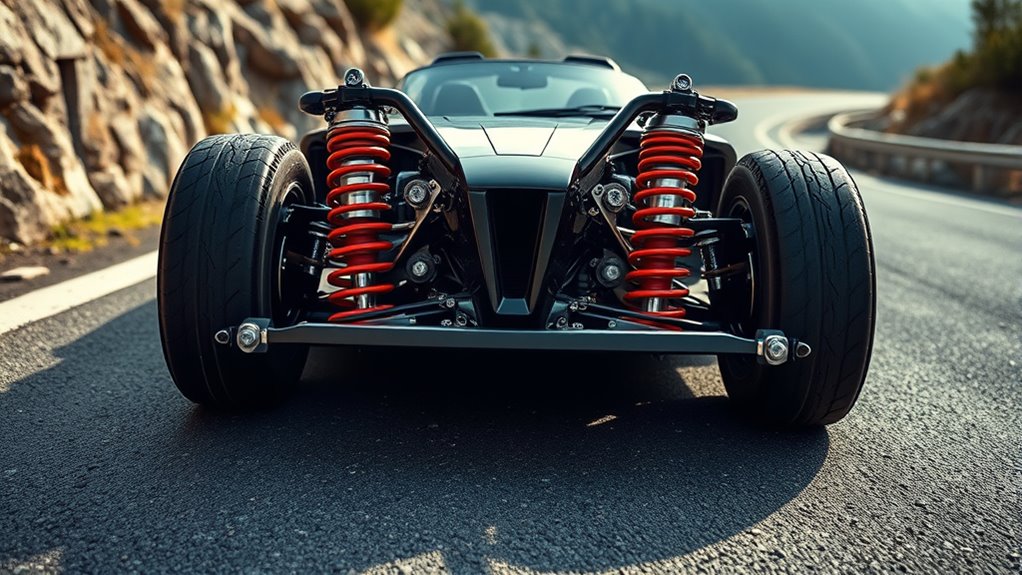
Spring rates directly influence how your vehicle handles turns and responds to road conditions. Choosing the right spring rate affects body roll, tire contact, and overall stability. Sound design techniques can even be applied to enhance the auditory experience of your vehicle’s performance in multimedia presentations. Higher spring rates reduce body lean during cornering, which keeps tires firmly planted and enhances grip. They also minimize camber change, improving traction and responsiveness. However, stiffer springs can make your ride harsher and less comfortable. Additionally, understanding Volkswagen Tuning principles can help you select spring rates that complement your engine upgrades for optimal performance. To optimize handling, consider these factors:
- *Balance between stiffness and comfort to suit your driving style*
- *Adjust spring rates to control oversteer or understeer tendencies*
- *Match spring rates with other suspension components for cohesive performance*
Selecting appropriate spring rates helps you achieve a setup that enhances cornering, stability, and driver confidence, whether for daily driving or high-performance racing.
Dampers: Monotube vs. Twin-Tube Designs
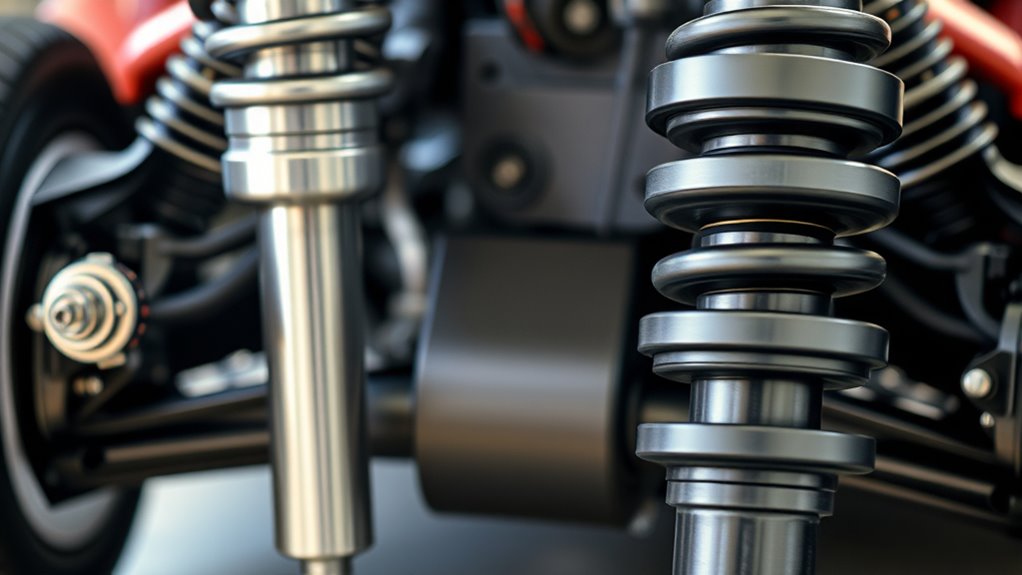
Understanding the fundamental differences between monotube and twin-tube dampers is essential when selecting the right suspension component for your vehicle.
Monotube shocks feature a single tube with all components inside, using a free piston to separate oil and gas. This design results in better heat dissipation and consistent damping. They’re preferred for high-performance and racing because of their precision and ease of customization. Monotube shocks are often used in racing applications due to their superior damping capabilities. Additionally, their ability to handle sustained stress makes them suitable for performance tuning where consistent damping is crucial.
Monotube shocks have a single tube design with internal components and a free piston for improved heat dissipation.
Twin-tube shocks, with two separate chambers, are more affordable and common for everyday driving. They reduce stress on seals and have less friction, making them durable in rough conditions. While monotube shocks handle heat and performance demands better, twin-tubes excel in cost and resilience.
Choose based on your driving style, performance needs, and budget to optimize your suspension setup.
The Role of Stabilizer Bars in Stability
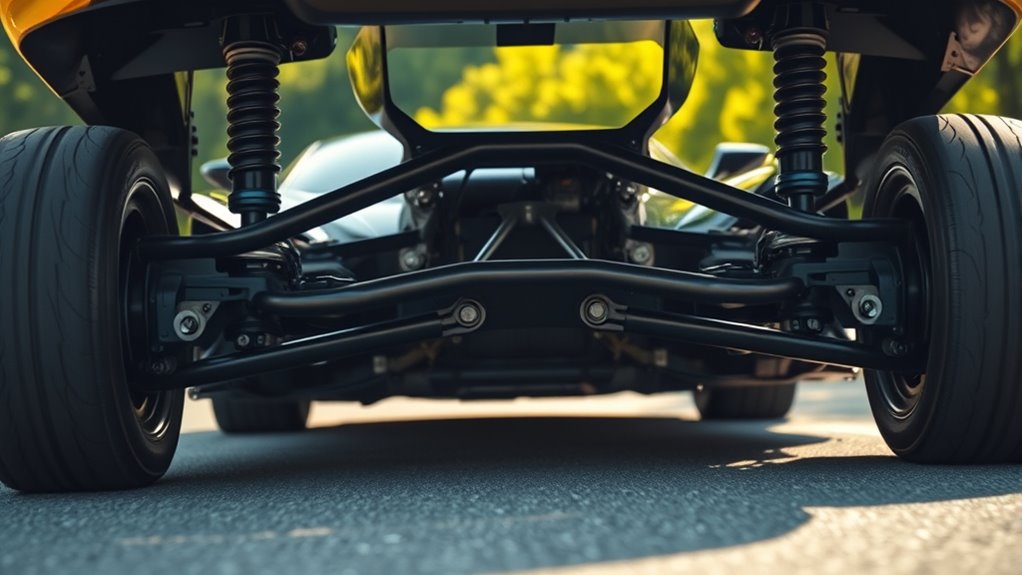
Stabilizer bars, also known as sway bars or anti-roll bars, play a critical role in enhancing your vehicle’s stability. They transfer force between the sides of your suspension, reducing body roll during turns. By exerting torsional force, they help distribute weight evenly across wheels, maintaining control. This force transfer improves cornering performance and keeps the vehicle stable, especially on bumpy roads. To fully understand their impact, consider these points: – They connect suspension components on opposite sides to balance forces. – Upgrading links or bars can substantially boost handling. – They work closely with control arms and struts to optimize stability. Proper suspension tuning enhances the effectiveness of stabilizer bars, ensuring a smoother and safer driving experience. Since they are part of the suspension system, a well-maintained stabilizer bar keeps your ride steady, improves grip, and reduces rollover risk, giving you confidence during aggressive driving or sharp turns.
Adjustability Options for Performance Tuning
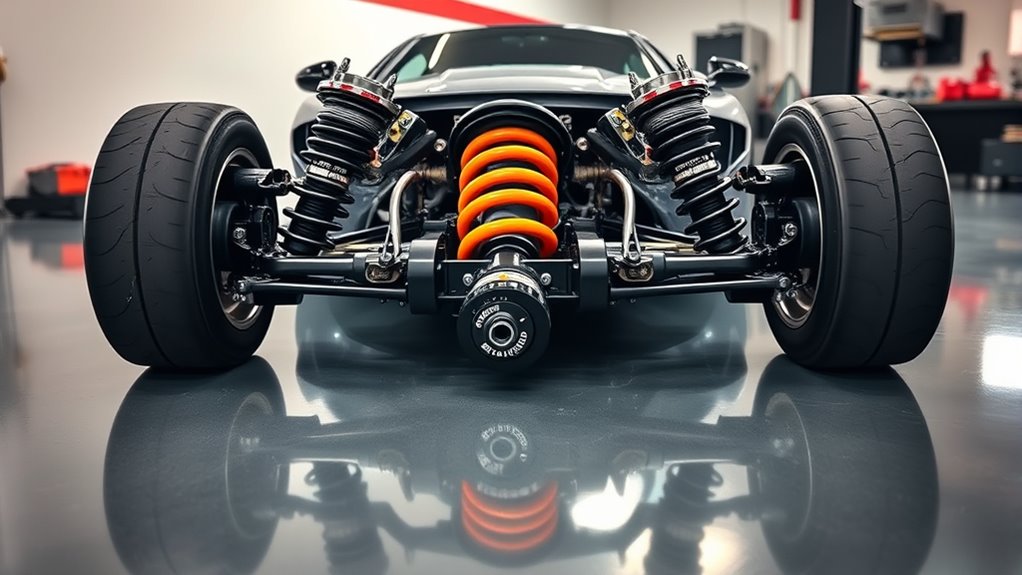
Adjustability options for performance tuning give you the ability to customize your suspension setup to match your driving style and track conditions. You can fine-tune spring rates and preload to balance comfort and handling—higher spring rates reduce body roll, while lower ones improve compliance on uneven surfaces. Proper component selection also ensures that your adjustments have the desired effect and maintain safety and durability. Adjustable preload lets you set ride height without changing spring stiffness. Damper adjustments, including compression and rebound damping, control how quickly your suspension compresses and extends, influencing stability during braking and cornering. Damping settings can be tailored to various driving scenarios to optimize grip and comfort. For example, AI-powered discoveries in vehicle technology can inform better suspension tuning by analyzing real-time data. Alignment geometry tweaks like camber, toe, and caster optimize tire contact and steering response. Bushings and mounts can be upgraded for sharper feedback, while ride height and corner weighting fine-tune balance and weight distribution. These options give you precise control over your car’s handling characteristics.
Considering Material Choices for Durability and Weight
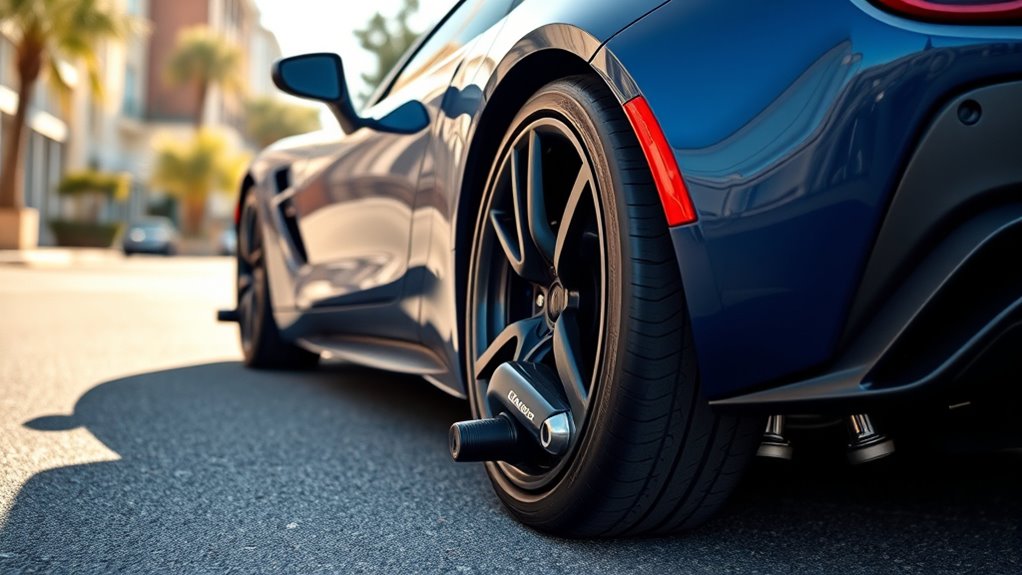
Choosing the right material for suspension components is essential because it directly affects both durability and weight. You need materials that withstand stress, resist corrosion, and keep the vehicle lightweight. Industry advancements have led to the development of composite coil springs that are 30-40% lighter and equally stable as steel, offering significant performance benefits. Steel offers strength and affordability but adds weight. Aluminum reduces weight without sacrificing impact resistance. GFRP and CFRP provide significant weight savings and corrosion resistance, though at higher costs. When selecting materials, consider: – corrosion resistance: GFRP and CFRP last longer in harsh environments. – Weight Reduction: Composites like GFRP and CFRP cut vehicle weight, enhancing performance. – Durability and Cost: Steel and aluminum balance durability with affordability, whereas composites are pricier but lighter. Matching material choices to your driving needs ensures a durable, lightweight setup that optimizes handling and longevity.
Tuning Principles for Balanced Handling and Comfort

Achieving the right balance between handling and comfort requires understanding how suspension components interact and influence vehicle dynamics. Stiffer springs reduce body roll but make your ride harsher, while softer springs improve bump absorption but can cause more body movement. Adjustable shocks let you fine-tune compression and rebound for stability and comfort. Proper wheel alignment is essential to optimize handling and tire wear, ensuring that your setup performs as intended. Lowering your car enhances cornering but risks scraping and a rougher ride, whereas stock height prioritizes comfort. Anti-roll bars help control lean without stiffening springs excessively. Proper bushings, like polyurethane, improve handling but transmit more road noise. To find your ideal setup, tweak coilovers, progressive springs, and damping settings incrementally. Consider tire sidewalls and weight distribution to optimize handling without sacrificing ride quality. Small adjustments lead to a balanced, confident driving experience.
Incorporating Advanced Suspension Technologies
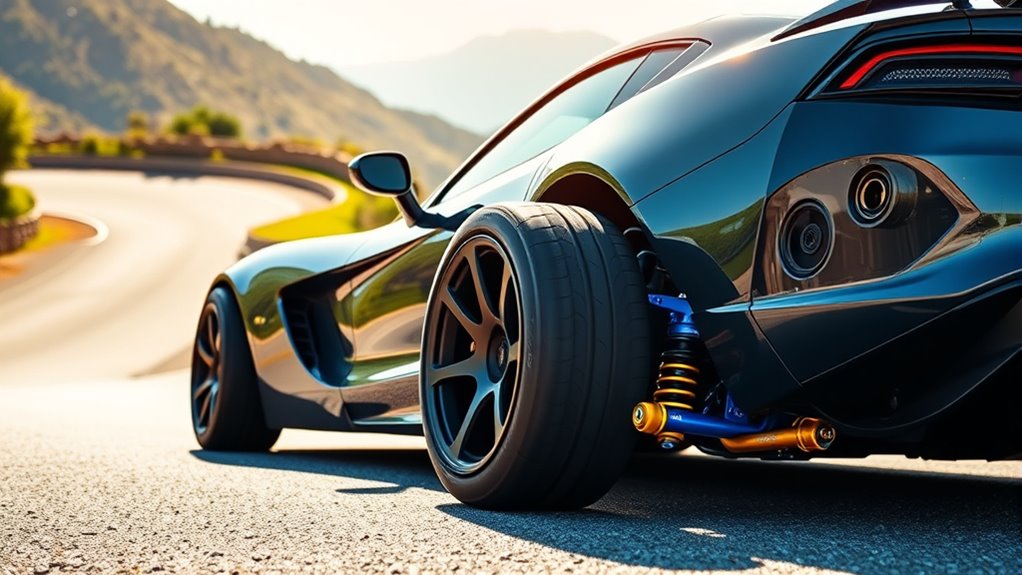
Modern suspension systems go beyond traditional setups by incorporating advanced technologies that continuously adapt to driving conditions. These innovations optimize your ride’s comfort and handling in real-time. Adaptive dampers, like magnetorheological (MR) systems, change stiffness instantly using electrically controlled fluids, balancing comfort and control during aggressive maneuvers. Air suspension systems replace coil springs with adjustable airbags, offering variable ride height and better adaptability on diverse surfaces. Fully active systems utilize electric actuators to control each wheel individually, eliminating body motions like roll and pitch. Additionally, predictive suspension technologies use sensors and cameras to anticipate road irregularities, proactively adjusting components. With over four decades of racing heritage, these advanced systems are designed to enhance ride comfort and handling seamlessly, minimize body motions for stability, and extend component lifespan through precision control.
Maintenance and Upkeep for Optimal Performance
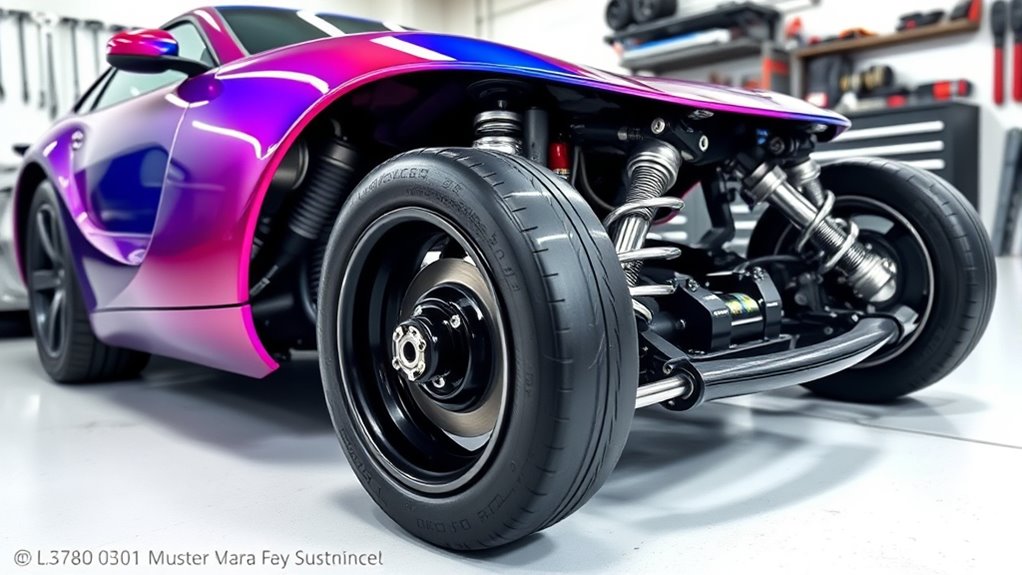
Regular maintenance is essential to keep your suspension system performing at its best and ensuring a smooth, stable ride. You should perform visual checks every 3-6 months for leaks, damage, or worn components like springs, shocks, and control arms. Schedule professional inspections annually or every 12,000 miles to evaluate ball joints, shocks, bushings, and other critical parts. Keep your suspension in top shape by lubricating joints during service, aligning wheels every 6-12 months, and rotating tires every 5,000-7,500 miles. Watch for signs of wear, such as unusual noises, pulling, or uneven tire wear. Replace worn shocks, control arms, or bushings promptly, and consider component upgrades or adjustments to optimize handling. Regular upkeep prevents failure, maintains performance, and extends your suspension’s lifespan. Additionally, proper maintenance helps identify early issues that could lead to more serious problems if left unaddressed.
Frequently Asked Questions
How Do I Determine the Best Suspension Setup for My Driving Style?
To find the best suspension setup for your driving style, start by considering how you use your car. If you race or track, go for stiffer setups for better handling.
For daily driving, softer suspensions give a smoother ride. Think about your vehicle’s weight and type, and consult professionals if needed.
Adjust components like coilovers and sway bars to match your preferences, balancing performance and comfort.
Can Aftermarket Suspension Components Improve Everyday Comfort?
You wonder if aftermarket suspension parts can truly boost your daily comfort. The answer is yes, but it’s nuanced. Upgrades like polyurethane bushings and strut braces reduce vibrations and body roll, making your ride smoother.
Coilovers and air suspension kits offer adjustable comfort levels, so you can tailor your driving experience. Investing in quality brands like Bilstein or KW guarantees durability and performance, transforming your everyday drive into a more comfortable journey.
What Are the Signs of Worn or Failing Suspension Parts?
If your suspension parts are worn or failing, you’ll notice your vehicle sitting unevenly, pulling to one side, or swaying excessively in turns.
You might hear squeaks, clunks, or rattles over bumps, and feel every jolt in your ride.
Steering could become difficult or imprecise, and tires may wear unevenly.
These signs indicate your suspension needs inspection and possibly replacement to restore safety, comfort, and handling.
Is It Necessary to Re-Align My Wheels After Suspension Upgrades?
Did you know that improper wheel alignment can reduce tire life by up to 30%?
After suspension upgrades, you definitely need to re-align your wheels. Changes in ride height and suspension geometry affect handling and tire wear.
Skipping this step can cause uneven tire wear, steering issues, and decreased safety.
Always follow manufacturer guidelines and get a professional alignment to guarantee your new setup performs at its best and stays safe on the road.
How Do Suspension Adjustments Affect Tire Wear and Longevity?
Suspension adjustments directly impact your tire wear and longevity. When you fine-tune your suspension, you improve alignment, ensuring your tires contact the road evenly.
Proper adjustments reduce uneven wear patterns like cupping or edge wear, helping your tires last longer. They also enhance handling and ride quality, preventing unnecessary stress on tires.
Regularly checking and adjusting your suspension keeps your tires in ideal condition, saving you money and boosting safety.
Conclusion
Think of your suspension as the backbone of your tuned car’s performance—like a skilled conductor guiding an orchestra. When you choose the right setup, you create harmony between handling and comfort, ensuring every ride feels balanced and responsive. With careful tuning and maintenance, you’ll keep your car performing at its best, like a finely tuned instrument ready to deliver a flawless performance. Ultimately, your suspension choices shape your driving symphony—so choose wisely and enjoy every note.
